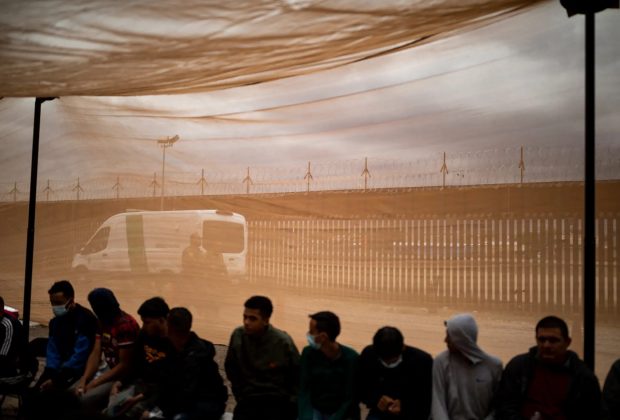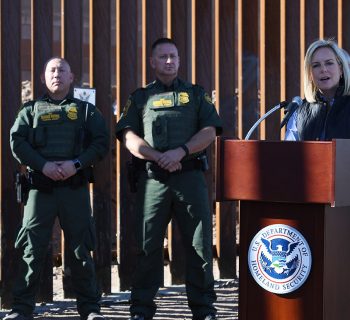Opinion by Dara Lind | The New York Times | MAR. 14, 2023 | Photo by Ivan Pierre Aguirre
How did President Biden go from denouncing the immigration policies of his predecessor to following in his footsteps by proposing a regulation that would make the vast majority of current asylum seekers ineligible? How did he go from decrying the detention of immigrant families to contemplating the mass use of it?
The answer is simple: The numbers went up. Current U.S. border policy — under a fig leaf known as Title 42, a statute activated under a Covid public health order that just about everyone candidly agrees isn’t about public health — puts most border crossers at risk of summary expulsion without any chance to seek asylum. Despite that, last year apprehension levels hit 20-year highs. With the planned expiration of the Title 42 order this spring, the Biden administration is pre-emptively on a crisis footing, rushing to ensure that it will have a crackdown ready for an anticipated surge of asylum seekers.
And that’s exactly the problem. The United States has been intermittently on crisis footing at the border for the past decade. Each administration keeps cycling restlessly through the same few ideas. A family detention facility that Mr. Biden might reopen was built under Barack Obama. The recently proposed regulation — which would essentially withhold asylum from anyone crossing into the United States illegally — is a variation on a proposal from Donald Trump.
The federal government is patently out of ideas. What makes this so frustrating is that it’s not hard to imagine other, better ways to evaluate the health of our immigration system and to improve it.
But we are now stuck in a border-crisis version of “Groundhog Day.” Border apprehensions go up; the administration panics and enacts harsher enforcement; apprehensions decline; the administration declares victory; border apprehensions go up again.
It would be tempting to assume the problem is that enforcement isn’t sustained, but evidence doesn’t back that up: For example, the Title 42 era has had both record lows in unauthorized border crossings and 21st-century highs. There are other determinants of migration outside the control of the United States and beyond the reach of our policies.
When apprehensions go down, instead of preparing for the inevitable next rise, whatever administration is in charge declares the crisis over and moves on with palpable relief. (Even as the Biden White House prepares for the end of Title 42, it has been taking a victory lap over a decline in the number of apprehensions since the fall.)
The state of crisis is defined by apprehension numbers, the number of people getting caught by or turning themselves in to the Border Patrol. Yet that number is incapable on its own of saying anything about the U.S. government’s capacity to deal with those border crossers or what happens to them after apprehension. Furthermore, it is impossible to crisis-proof the border because no investment in and of itself — even a wall — will stop people from being able to set foot on U.S. soil.
The only way to reduce the number of people caught by the Border Patrol is to try to intimidate them from coming. That is the strategy of deterrence that the United States has been using since 2014: telling people not to come and trying to make sure that the people already coming are treated poorly enough that the same message spreads through word of mouth.
Imagine if the only metric of the U.S. economy that anyone cared about — the only one that got reported on month to month or that was addressed in cabinet meetings — was the number of people who left a company’s payroll in a month. It would be reasonable to assume that the U.S. government would focus nearly all its efforts on preventing people from losing their jobs, wholly ignoring other aspects of economic health like purchasing power and gross domestic product. Its efforts might tend toward the overdesigned (like trying to shape incentives in specific states and industries, to predict exactly where companies might be tempted to downsize) or the overly blunt, doing everything short of passing a law preventing companies from firing anyone.
No one thinks of job loss in and of itself as a good thing. But mature policymaking requires acknowledging that there are nuances — like the difference between two-week “funemployment” and six-month (or longer) unemployment — and that there are many interests involved that must be balanced.
There are multiple interests in immigration policy, too: the United States’ historical humanitarian commitment not to deport people back to a country where they will be persecuted, for example, and a sensitivity toward the conditions in which children and families are held in government custody. White House officials take umbrage at comparing their transit ban to Mr. Trump’s, because they stress there are significant exceptions to the ban. They promise that this time, they won’t end up holding families in jail-like conditions for months.
Yet deterrence sends just one blunt message: no. If the message is “probably not” or “hold on, let’s check,” the policy will fail on its own terms.
One of two things will be true of our post-Title 42 border policy. The ban will function as a ban, and families will be forced through a multistep process to determine their ineligibility for asylum within 20 days (the point at which courts have said the United States must generally release them). Or the exceptions will be real, and large numbers of people will remain here to pursue their cases — thus requiring their release from detention and muddying the message sent to their countries of origin.
Either the Biden administration will go back on its humanitarian promises or it will undercut the brute deterrent effectiveness of its policy. Either way, it’s sabotaging itself.
There are other ways to measure the health of our immigration system. A system that cared about maximizing orderly asylum claims would focus on scaling up the capacity at ports of entry to conduct orderly asylum interviews rather than forcing people to use Customs and Border Protection’s notoriously buggy CBP One app in the hopes of setting up scarce appointments.
A system that cared primarily about processing people quickly and safely would invest in facilities to house them that weren’t effectively jails. A system that cared about ensuring no one skipped out on a court date would guarantee clear communication from the courts — and maybe even lawyers to help immigrants navigate the system. A system that cared about executing removal orders would station Immigration and Customs Enforcement agents in courtrooms.
Some of these are more appealing than others to me and perhaps to you, but that’s part of the point: There are so many other ways for hawks or doves to get what they want, and talking openly about what they want the system to accomplish can refocus the discussion on things that are actually within the government’s control.
It’s time to let go of the fantasy of solving a border crisis, with the uncomfortable — and unsupported — implication that the only successful border policy is the least humane one.







